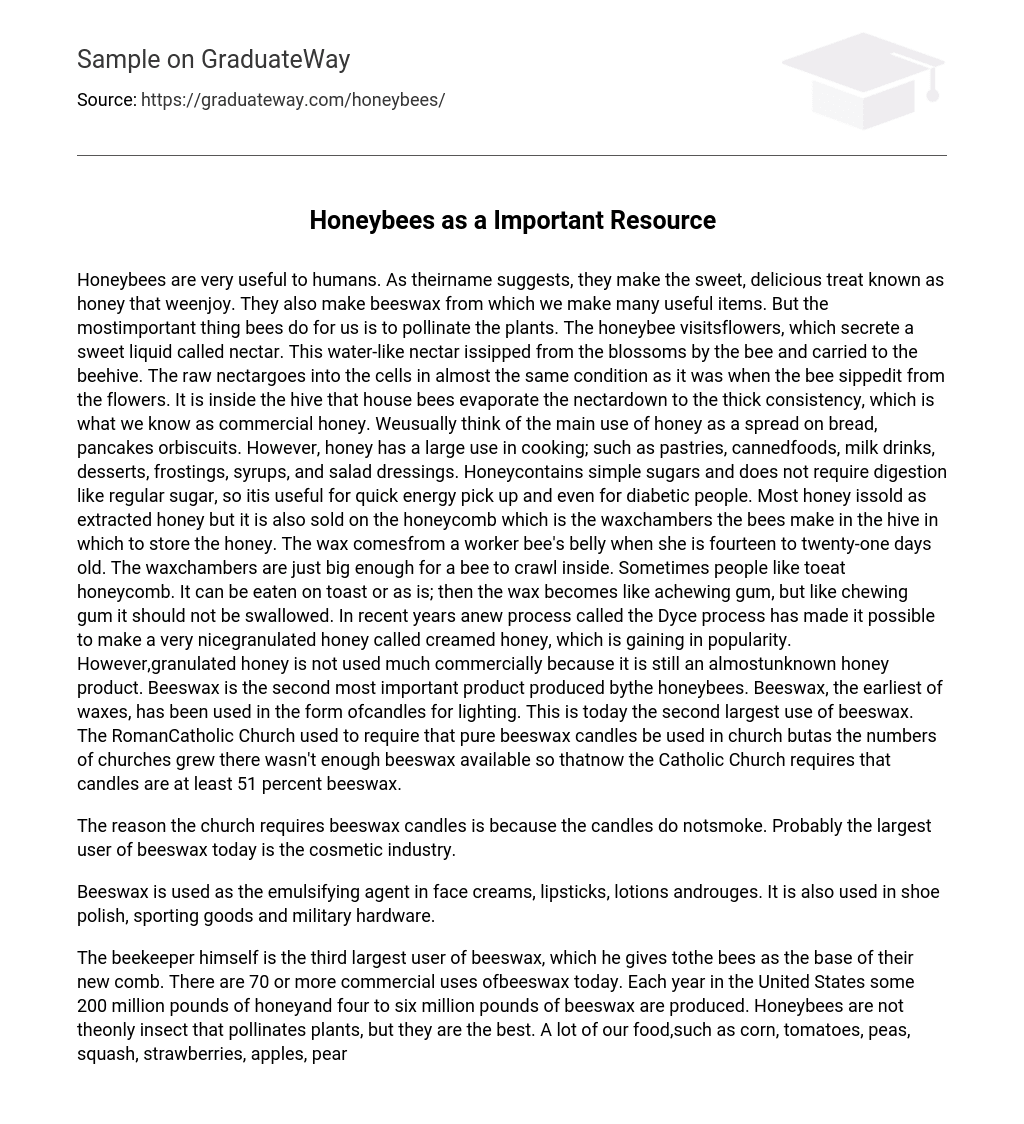Honeybees are very useful to humans. As theirname suggests, they make the sweet, delicious treat known as honey that weenjoy. They also make beeswax from which we make many useful items. But the mostimportant thing bees do for us is to pollinate the plants. The honeybee visitsflowers, which secrete a sweet liquid called nectar. This water-like nectar issipped from the blossoms by the bee and carried to the beehive. The raw nectargoes into the cells in almost the same condition as it was when the bee sippedit from the flowers. It is inside the hive that house bees evaporate the nectardown to the thick consistency, which is what we know as commercial honey. Weusually think of the main use of honey as a spread on bread, pancakes orbiscuits. However, honey has a large use in cooking; such as pastries, cannedfoods, milk drinks, desserts, frostings, syrups, and salad dressings. Honeycontains simple sugars and does not require digestion like regular sugar, so itis useful for quick energy pick up and even for diabetic people. Most honey issold as extracted honey but it is also sold on the honeycomb which is the waxchambers the bees make in the hive in which to store the honey. The wax comesfrom a worker bee’s belly when she is fourteen to twenty-one days old. The waxchambers are just big enough for a bee to crawl inside. Sometimes people like toeat honeycomb. It can be eaten on toast or as is; then the wax becomes like achewing gum, but like chewing gum it should not be swallowed. In recent years anew process called the Dyce process has made it possible to make a very nicegranulated honey called creamed honey, which is gaining in popularity. However,granulated honey is not used much commercially because it is still an almostunknown honey product. Beeswax is the second most important product produced bythe honeybees. Beeswax, the earliest of waxes, has been used in the form ofcandles for lighting. This is today the second largest use of beeswax. The RomanCatholic Church used to require that pure beeswax candles be used in church butas the numbers of churches grew there wasn’t enough beeswax available so thatnow the Catholic Church requires that candles are at least 51 percent beeswax.
The reason the church requires beeswax candles is because the candles do notsmoke. Probably the largest user of beeswax today is the cosmetic industry.
Beeswax is used as the emulsifying agent in face creams, lipsticks, lotions androuges. It is also used in shoe polish, sporting goods and military hardware.
The beekeeper himself is the third largest user of beeswax, which he gives tothe bees as the base of their new comb. There are 70 or more commercial uses ofbeeswax today. Each year in the United States some 200 million pounds of honeyand four to six million pounds of beeswax are produced. Honeybees are not theonly insect that pollinates plants, but they are the best. A lot of our food,such as corn, tomatoes, peas, squash, strawberries, apples, pears, andwatermelon would not continue without this pollination. During the last threeweeks of a worker bee’s life, they fly out of the hives as a forager. The beestake pollen and nectar to the hive and deposit it into cells. During a foragingtrip each individual bee will collect pollen from just one kind of plant. Bydoing this, each bee helps pollinate the blossoms. When the bee crawls around onthe blossom, the pollen (containing male plant reproductive cells) clings tofine hairs located on the bee’s legs. The pollen is carried from one blossom toanother blossom of the same kind of plant, where it sticks to the female part ofthe flower. Without pollination plants would not produce fruit or seeds. Withoutseeds now new plants could grow. Pollen is carried in small pollen baskets onthe outer sides of the bees legs. In order to fill the baskets with pollen, thebee uses her mouth parts and scrapes the pollen from the blossoms and hairs onher leg to secure it in the basket. The pollen is also known as “beebread.” This is because the bee eats the pollen. When bees find a goodsupply of food they use “sign language.” They return to the hive andperform a dance to show other bees where to find food. There are two kinds ofdances. The round dance tells the other bees that food is about 100 yards awayor less. The wagging dance tells bees that food is at such an angle to the sunand how far away the food lies. Tests have been made and even if the food ismiles away, this dance is still extremely accurate. For some people bee venom isdeadly, but for some people bee venom is good medicine. Some people who havearthritis (a swelling and pain in joints) pick up a bee by her head and hold hertail to the sore joint until the bee stings. The venom makes the joint swell upand this flushes out the arthritis. So as you can see, honeybees give us honey,wax, and comb. They also pollinate our flowers. Therefore they are a veryimportant resource.
Zoology and Animals





